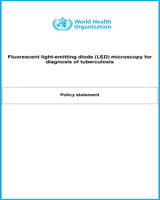Conventional light microscopy of Ziehl-Neelsen-stained smears prepared directly from sputum specimens is the most widely available test for diagnosis of tuberculosis (TB) in resource-limited settings. Ziehl-Neelsen microscopy is highly specific, but its sensitivity is variable (20–80%) and is significantly reduced in patients with extrapulmonary TB and in HIV-infected TB patients. Conventional fluorescence microscopy is more sensitive than Ziehl-Neelsen and takes less time, but its use has been limited by the high cost of mercury vapour light sources, the need for regular maintenance and the requirement for a dark room.
Light-emitting diodes (LED) have been developed to offer the benefits of fluorescence microscopy without the associated costs. In 2009, the evidence for the efficacy of LED microscopy was assessed by the World Health Organization (WHO), on the basis of standards appropriate for evaluating both the accuracy and the effect of new TB diagnostics on patients and public health. The results showed that the accuracy of LED microscopy was equivalent to that of international reference standards, it was more sensitive than conventional Ziehl-Neelsen microscopy and it had qualitative, operational and cost advantages over both conventional fluorescence and Ziehl- Neelsen microscopy.
On the basis of these findings, WHO recommends that conventional fluorescence microscopy be replaced by LED microscopy, and that LED microscopy be phased in as an alternative for conventional Ziehl-Neelsen light microscopy. The switch to LED microscopy should be carefully phased in at country level, with LED technology that meets WHO specifications. Countries using LED microscopy should train laboratory staff, validate the technique, introduce appropriate quality assurance and monitor the effect on TB case detection rates and treatment outcomes.

